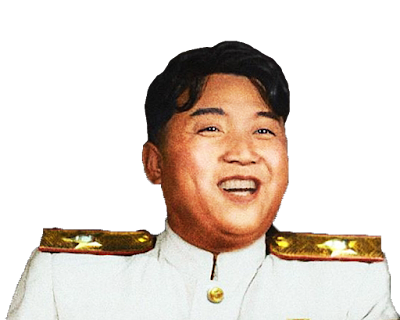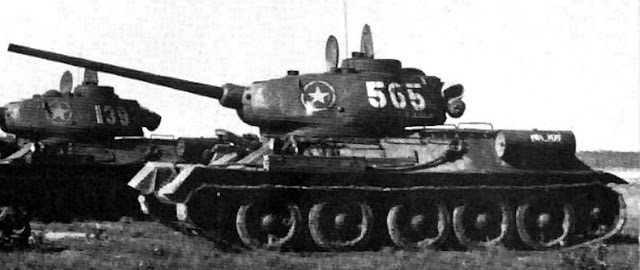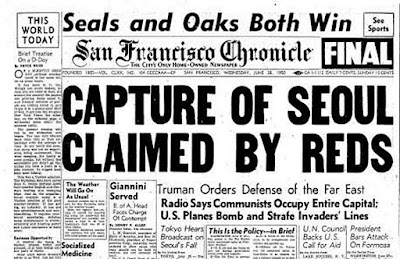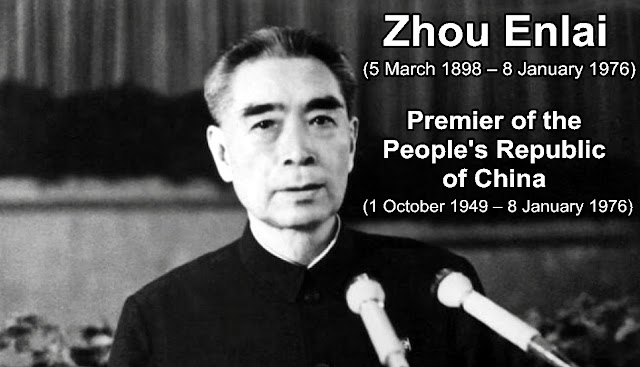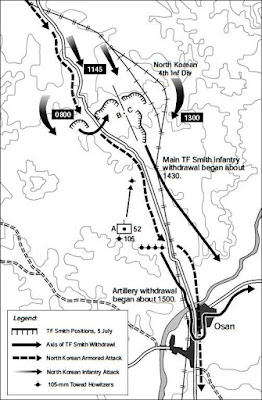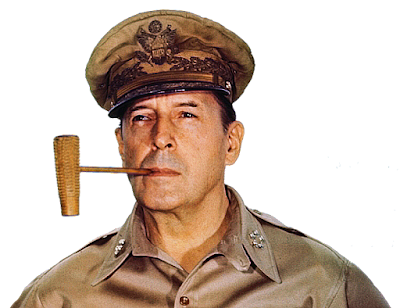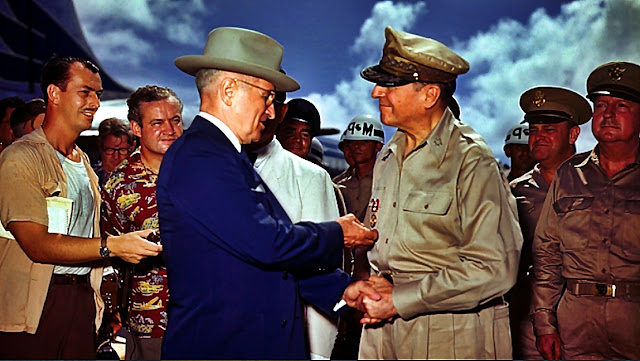The Korean War (25 June 1950 – 27 July 1953) was a conflict between the Democratic People’s Republic of Korea (North Korea) and the Republic of Korea (South Korea) in which at least 2.5 million persons lost their lives. The war began when North Korea, supplied and advised by the Soviet Union, invaded the South. The United Nations, with the United States as the principal participant, joined the war on the side of the South Koreans, and the People’s Republic of China came to North Korea’s aid. After more than a million combat casualties had been suffered on both sides, the fighting ended in July 1953 with Korea still divided into two hostile states. Negotiations in 1954 produced no further agreement, and the front line has been accepted ever since as the de facto boundary between North and South Korea.
In 1910, Japan put Korea under Japanese rule and was still ruling Korea when World War 2 ended. At the Cairo Conference in November 1943, China, the United Kingdom, and United States all decided "in due course Korea shall become free and independent". When Japan surrendered, the United States and the Soviet Union agreed in August 1945 to divide the country for administrative purposes at the 38th parallel, into two temporary occupation zones with USSR occupying the North and USA occupying the South. This was, at first, to be for a short time. At the Moscow Conference of the Council of Foreign Ministers in December 1945, the United States and USSR agreed on Korea having a provisional government.
A general election was held in the South Korea on 10 May 1948. North Korea held parliamentary elections three months later on 25 August. The resultant South Korean government promulgated a national political constitution on 17 July 1948, and elected Syngman Rhee as President on 20 July 1948. The Republic of Korea (South Korea) was established on 15 August 1948. In the Russian Korean Zone of Occupation, the Soviet Union established a communist government led by Kim Il-sung. Kim Il-sung was a Major in the Soviet Red Army and served in it until the end of World War 2. Kim arrived in the Korean port of Wonsan on 19 September 1945 after 26 years in exile. In 17 December 1945, the Soviets installed Kim as chairman of the North Korean branch of the Korean Communist Party. By 1949, Kim and the communists had consolidated totalitarian rule in North Korea. Around this time, the cult of personality was promoted by the communists, the first statues of Kim appeared, and he began calling himself "Great Leader".
With the end of the war with Japan, the Chinese Civil War resumed between the Chinese Communists and the Chinese Nationalists. While the Communists were struggling for supremacy in Manchuria, they were supported by the North Korean government with matériel and manpower. The North Korean contributions to the Chinese Communist victory were not forgotten after the creation of the People's Republic of China in 1949. China promised to support the North Koreans in the event of a war against South Korea.
The Cold War was an important cause in the Korean War. Relations between the two occupying powers were bad and when China became Communist in October 1949, the President of the USA, Harry Truman, was very worried that other countries around China may also become Communist, such as Japan. The American Army was about one twelfth the size of five years earlier and Joseph Stalin had recently lost a Cold War dispute over the Berlin Blockade and subsequent airlift.
North Korea's decision to invade South Korea was Kim's initiative, not a Soviet one. Evidence suggests that Soviet intelligence, through its espionage sources in the US government and British SIS, had obtained information on the limitations of US atomic bomb stockpiles as well as defense program cuts, leading Stalin to conclude that the Truman administration would not intervene in Korea.
The Americans had not intervened to stop the communist victory in China, and Stalin calculated that the Americans would be even less willing to fight in Korea—which had seemingly much less strategic significance. The Soviets had also cracked the codes used by the US to communicate with the US embassy in Moscow, and reading these dispatches convinced Stalin that Korea did not have the importance to the US that would warrant a nuclear confrontation.
In April 1950, Stalin gave Kim permission to invade the South under the condition that Mao would agree to send reinforcements if they became needed. Stalin made it clear that Soviet forces would not openly engage in combat, to avoid a direct war with the Americans. Kim met with Mao in May 1950. Mao was concerned that the Americans would intervene but agreed to support the North Korean invasion. China desperately needed the economic and military aid promised by the Soviets. However, Mao sent more ethnic Korean veterans to Korea and promised to move an army closer to the Korean border. Once Mao's commitment was secured, preparations for war accelerated.
By mid-1950, North Korean forces numbered between 150,000 and 200,000 troops, organized into 10 infantry divisions, one tank division, and one air force division, with 210 fighter planes and 280 tanks. In contrast, the South Korean Army defenders were relatively unprepared and ill-equipped. They had 98,000 soldiers (65,000 combat, 33,000 support), no tanks (they had been requested from the U.S. military, but requests were denied), and a 22-piece air force comprising 12 liaison-type and 10 AT6 advanced-trainer airplanes.
On 7 June 1950, Kim Il-sung called for a Korea-wide election on 5–8 August 1950 and a consultative conference in Haeju on 15–17 June 1950. On 11 June, the North sent three diplomats to the South, as a peace overture that Rhee rejected. At dawn on Sunday, 25 June 1950, the Korean People's Army crossed the 38th parallel behind artillery fire. The Korean People's Army justified its assault with the claim that Republic of Korea Army troops had attacked first, and that they were aiming to arrest and execute the "bandit traitor Syngman Rhee".
On 27 June, Rhee evacuated from Seoul with some of the government. On 28 June, at 2 am, the South Korean Army blew up the highway Hangang Bridge across the Han River in an attempt to stop the North Korean army. The bridge was detonated while 4,000 refugees were crossing it, and hundreds were killed. Destroying the bridge also trapped many South Korean military units north of the Han River. In spite of such desperate measures, Seoul fell that same day. In five days, the South Korean forces, which had 95,000 men on 25 June, was down to less than 22,000 men. In early July, when U.S. forces arrived, what was left of the South Korean forces were placed under U.S. operational command of the United Nations Command.
President Truman ordered General MacArthur to transfer matériel to the Army of the Republic of Korea while giving air cover to the evacuation of U.S. nationals. The President disagreed with advisers who recommended unilateral U.S. bombing of the North Korean forces, and ordered the US Seventh Fleet to protect the Republic of China (Taiwan), whose government asked to fight in Korea. The United States denied Taiwan’s request for combat, lest it provoke a communist Chinese retaliation. Because the United States had sent the Seventh Fleet to "neutralize" the Taiwan Strait, Chinese premier Zhou Enlai criticized both the United Nations and U.S. initiatives as "armed aggression on Chinese territory."
On 25 June 1950, the United Nations Security Council unanimously condemned the North Korean invasion of the Republic of Korea, with United Nations Security Council Resolution 82. The Soviet Union, a veto-wielding power, had boycotted the Council meetings since January 1950, protesting that the Republic of China (Taiwan), not the People's Republic of China, held a permanent seat in the United Nations Security Council. After debating the matter, the Security Council, on 27 June 1950, published Resolution 83 recommending member states provide military assistance to the Republic of Korea. On 27 June President Truman ordered U.S. air and sea forces to help the South Korean regime. On 4 July the Soviet Deputy Foreign Minister accused the United States of starting armed intervention on behalf of South Korea.
The Battle of Osan, the first significant American engagement of the Korean War, involved the 540-soldier Task Force Smith, which was a small forward element of the 24th Infantry Division which had been flown in from Japan. On 5 July 1950, Task Force Smith attacked the North Koreans at Osan but without weapons capable of destroying the North Koreans' tanks. They were unsuccessful; the result was 180 dead, wounded, or taken prisoner. The Korean People's Army progressed southwards, pushing back the US force at Pyongtaek, Chonan, and Chochiwon, forcing the 24th Division's retreat to Taejeon, which the Korean People's Army captured in the Battle of Taejon.
By August, the Korean People's Army had pushed back the Republic of Korea Army and the Eighth United States Army to the vicinity of Pusan in southeast Korea. By September, the United Nations Command controlled the Pusan perimeter, enclosing about 10% of Korea, in a line partially defined by the Nakdong River. Supplies came through the port at Pusan, where the Eighth Army’s logistics system depended on Korean and Japanese technicians and on thousands of Korean labourers. To stop the North Koreans’ tanks and supporting artillery and infantry, they brought in Sherman and Pershing medium tanks, rocket launchers, artillery pieces, antiaircraft guns, and, most important of all, close-air-support aircraft. The Fifth Air Force attacked forward units of the Korean People's Army with World War 2-era P-51 Mustangs, new jet-powered F-80s and F-84s, and even B-26 and B-29 bombers.
Although Kim's early successes had led him to predict that he would end the war by the end of August, Chinese leaders were more pessimistic. To counter a possible U.S. deployment, Zhou Enlai secured a Soviet commitment to have the Soviet Union support Chinese forces with air cover, and deployed 260,000 soldiers along the Korean border, under the command of Gao Gang. Chinese advisors concluded that MacArthur would most likely attempt a landing at Incheon.
In the resulting Battle of Pusan Perimeter (August–September 1950), the U.S. Army withstood Korean People's Army attacks meant to capture the city at the Naktong Bulge, P'ohang-dong, and Taegu. The United States Air Force interrupted Korean People's Army logistics with 40 daily ground support sorties that destroyed 32 bridges, halting most daytime road and rail traffic. Korean People's Army forces were forced to hide in tunnels by day and move only at night. In early September 1950, Republic of Korea Army and United Nations Command forces outnumbered the Korean People's Army 180,000 to 100,000 soldiers. The United Nations forces, once prepared, counterattacked and broke out of the Pusan Perimeter.
Against the rested and re-armed Pusan Perimeter defenders and their reinforcements, the Korean People's Army were undermanned and poorly supplied; unlike the United Nations Command, they lacked naval and air support. To relieve the Pusan Perimeter, General MacArthur recommended an amphibious landing at Inchon, near Seoul and well over 100 miles (160 km) behind the Korean People's Army lines. The operation involved some 75,000 troops and 261 naval vessels, and began on 15 September 1950. On 25 September, Seoul was recaptured by South Korean forces. American air raids caused heavy damage to the Korean People's Army, destroying most of its tanks and much of its artillery. North Korean troops in the south, instead of effectively withdrawing north, rapidly disintegrated, leaving Pyongyang vulnerable. During the general retreat only 25,000 to 30,000 soldiers managed to rejoin the Northern Korean People's Army lines.
On 27 September, MacArthur received the top secret National Security Council Memorandum 81/1 from Truman reminding him that operations north of the 38th parallel were authorized only if "at the time of such operation there was no entry into North Korea by major Soviet or Chinese Communist forces, no announcements of intended entry, nor a threat to counter our operations militarily...". On 30 September, Zhou Enlai warned the United States that China was prepared to intervene in Korea if the United States crossed the 38th parallel.
By 1 October 1950, the United Nations Command repelled the Korean People's Army northwards past the 38th parallel; the Republic of Korea Army crossed after them, into North Korea. The Eighth U.S. Army and the Republic of Korea Army drove up western Korea and captured Pyongyang city, the North Korean capital, on 19 October 1950. Taking advantage of the United Nations Command's strategic momentum against the communists, General MacArthur believed it necessary to extend the Korean War into China to destroy depots supplying the North Korean war effort. President Truman disagreed, and ordered caution at the Sino-Korean border.
On 8 October 1950, Mao Zedong redesignated the People's Liberation Army North East Frontier Force as the Chinese People's Volunteer Army in order to prevent an official war with the United States. In order to enlist Stalin's support, Zhou and a Chinese delegation left for Moscow on 8 October, arriving there on 10 October at which point they flew to Stalin's home at the Black Sea. There they conferred with the top Soviet leadership which included Joseph Stalin as well as Vyacheslav Molotov, Lavrentiy Beria and Georgi Malenkov. Immediately on his return to Beijing on 18 October 1950, Zhou met with Mao Zedong, Peng Dehuai, and Gao Gang, and the group ordered two hundred thousand Chinese troops to enter North Korea, which they did on 25 October.
United Nations aerial reconnaissance had difficulty sighting People's Volunteer Army units in daytime, because their march and bivouac discipline minimized aerial detection. The People's Volunteer Army marched "dark-to-dark" (7PM–3AM). Meanwhile, daylight advance parties scouted for the next bivouac site. During daylight activity or marching, soldiers were to remain motionless if an aircraft appeared, until it flew away. People's Volunteer Army officers were under order to shoot security violators. Such battlefield discipline allowed a three-division army to march the 286 miles (460 km) from An-tung, Manchuria, to the combat zone in some 19 days. Another division night-marched a circuitous mountain route, averaging 18 miles (29 km) daily for 18 days.
After secretly crossing the Yalu River on 19 October, the People's Volunteer Army 13th Army Group launched the First Phase Offensive on 25 October, attacking the advancing United Nations forces near the Sino-Korean border. After decimating the Republic of Korea Army 2 Corps at the Battle of Onjong, the first confrontation between Chinese and U.S. military occurred on 1 November 1950; deep in North Korea, thousands of soldiers from the People's Volunteer Army 39th Army encircled and attacked the U.S. 8th Cavalry Regiment with three-prong assaults—from the north, northwest, and west—and overran the defensive position flanks in the Battle of Unsan. The surprise assault resulted in the Unied Nations forces retreating back to the Ch'ongch'on River, while the Chinese unexpectedly disappeared into mountain hideouts following victory.
On 25 November at the Korean western front, the People's Volunteer Army 13th Army Group attacked and overran the Republic of Korea 2 Corps at the Battle of the Ch'ongch'on River, and then decimated the US 2nd Infantry Division on the United Nations forces' right flank. The United Nations Command retreated; the U.S. Eighth Army's retreat (the longest in US Army history) was made possible because of the Turkish Brigade's successful, but very costly, rear-guard delaying action near Kunuri that slowed the People's Volunteer Army attack for two days (27–29 November).
By 30 November, the People's Volunteer Army 13th Army Group managed to expel the U.S. Eighth Army from northwest Korea. Retreating from the north faster than they had counter-invaded, the Eighth Army crossed the 38th parallel border in mid December. In northeast Korea by 11 December, the U.S. 10 Corps managed to cripple the People's Volunteer Army 9th Army Group while establishing a defensive perimeter at the port city of Hungnam. The 10 Corps were forced to evacuate by 24 December in order to reinforce the badly depleted U.S. Eighth Army to the south.
The People's Volunteer Army and the Korean People's Army launched their Third Phase Offensive (also known as the "Chinese New Year's Offensive") on New Year's Eve of 1950. Utilizing night attacks in which United Nations Command fighting positions were encircled and then assaulted by numerically superior troops who had the element of surprise, the attacks were accompanied by loud trumpets and gongs, which fulfilled the double purpose of facilitating tactical communication and mentally disorienting the enemy. United Nations forces initially had no familiarity with this tactic, and as a result some soldiers panicked, abandoning their weapons and retreating to the south. The Chinese New Year's Offensive overwhelmed United Nations forces, allowing the People's Volunteer Army and Korean People's Army to conquer Seoul for the second time on 4 January 1951.
These setbacks prompted General MacArthur to consider using nuclear weapons against the Chinese or North Korean interiors, with the intention that radioactive fallout zones would interrupt the Chinese supply chains. United Nations forces retreated to Suwon in the west, Wonju in the center, and the territory north of Samcheok in the east, where the battlefront stabilized and held. The People's Volunteer Army had outrun its logistics capability and thus were unable to press on beyond Seoul as food, ammunition, and matériel were carried nightly, on foot and bicycle, from the border at the Yalu River to the three battle lines.
On 7 March 1951, the Eighth Army attacked with Operation Ripper, expelling the People's Volunteer Army and the Korean People's Army from Seoul on 14 March 1951. This was the city's fourth conquest in a years' time, leaving it a ruin; the 1.5 million pre-war population was down to 200,000, and people were suffering from severe food shortages.
On 11 April 1951, Commander-in-Chief Truman relieved the controversial General MacArthur, the Supreme Commander in Korea. There were several reasons for the dismissal. MacArthur had crossed the 38th parallel in the mistaken belief that the Chinese would not enter the war, leading to major allied losses. He believed that whether or not to use nuclear weapons should be his own decision, not the President's. MacArthur threatened to destroy China unless it surrendered. While MacArthur felt total victory was the only honorable outcome, Truman was more pessimistic about his chances once involved in a land war in Asia, and felt a truce and orderly withdrawal from Korea could be a valid solution.
Operations Courageous (23–28 March 1951) and Tomahawk (23 March 1951) were a joint ground and airborne infilltration meant to trap Chinese forces between Kaesong and Seoul. United Nations forces advanced to "Line Kansas", north of the 38th parallel.
For the remainder of the Korean War the United Nations Command and the People's Volunteer Army fought, but exchanged little territory; the stalemate held. Large-scale bombing of North Korea continued, and protracted armistice negotiations began on 10 July 1951 at Kaesong. The on-again, off-again armistice negotiations continued for two years. The United Nations Command, supported by the United States, the North Korean People's Army, and the Chinese People's Volunteers, signed the Armistice Agreement on 27 July 1953 to end the fighting. The Armistice also called upon the governments of South Korea, North Korea, China and the United States to participate in continued peace talks. The war is considered to have ended at this point, even though there was no peace treaty.
According to the data from the U.S. Department of Defense, the United States suffered 33,686 battle deaths, along with 2,830 non-battle deaths, during the Korean War. U.S. battle deaths were 8,516 up to their first engagement with the Chinese on 1 November 1950. South Korea reported some 373,599 civilian and 137,899 military deaths. Western sources estimate the People's Volunteer Army suffered about 400,000 killed and 486,000 wounded, while the North Korean People's Army suffered 215,000 killed and 303,000 wounded.
Postwar recovery was different in the two Koreas. Initially, South Korea suffered economically in the 1950s and later transitioned to democracy with a rapidly growing market economy, becoming one of the East Asian Tigers and reaching 11th place in its gross domestic product. Politically, South Korea had an authoritarian form of government until the 1987 establishment of the Sixth Republic. In North Korea, modest economic growth in the 1950s has not been followed by continuous growth. Withdrawal of Soviet support and catastrophic weather led to a near collapse of the economy by the late 1990s. Politically, North Korea removed references to communism from its constitution and emphasized a system of Juche, which prioritizes self-reliance and national independence.




